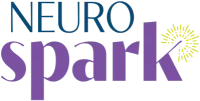
Table of Contents:
What is AuDHD?
AuDHD is a term that many members of the neurodivergent community use to describe the experience of being both autistic and ADHD. AuDHD is not a clinical term, and it doesn’t appear in the DSM, but it is a lived experience term created by the community that is both short and sweet. It makes sense. It combines the first two letters of autism with the letters of ADHD. It is pronounced “Aw-D.H.D.”
While it is okay to say “an autistic person who also has ADHD,” or “an autistic ADHDer,” or something similar, that can sometimes be a mouthful. AuDHD is an acceptable and welcome term for those who wish to use it. As always, respect the language that one identifies with and feels comfortable with. The best way to know how someone wishes to describe themselves is to ask them!
What does AuDHD mean?
AuDHD describes the co-occurring lived experiences of both autism and ADHD. This combination is more common than initially recognized by the medical field. That’s because autism and ADHD could not be diagnosed together until the DSM-5 was published in 2013. The field is still catching up. To date, there is little research around AuDHD specifically. It has been estimated that 50% to 70% of autistic people also meet criteria for ADHD, and an estimated 20% to 50% of people with ADHD also meet criteria for autism.
How is AuDHD experienced?
Just like autism is a spectrum, the manifestations and experiences of AuDHD can vary greatly from person to person. There is an overlap between autism and ADHD, and there are also significant distinctions. Members of the community who share about their lived experience as AuDHDers typically agree that the two neurodivergencies sometimes work together synchronously, and in other situations, they can be contradictory. For example, the autistic tendency towards familiarity and routine coexists with the ADHD tendency to struggle with routine and crave novelty. The AuDHD can also be very harmonious at times, such as when ADHD hyperfocus aligns with autistic monotropism, hyperfixation, and special interests. Both autistics and ADHDers can also become over- or understimulated. Both autistics and ADHDers can face relationship challenges.
Some of our clients choose to pursue AuDHD assessment because they have been previously diagnosed or self-identified with one of them, but they came to realize that it didn’t completely encapsulate their experience. They may strongly identify with one diagnosis, but still feel like part of their story is missing.
Many clients also choose to pursue an AuDHD assessment for purposes of self-understanding and self-discovery. They want to seek validation and understanding for their neurodivergence, and receive as much information as they can about their combination of traits and experiences.
What does AuDHD feel like?
Members of the community have described AuDHD as feeling like they have a brain operating on two different wavelengths. Some AuDHDers have shared that they identify with the experience of being an “extroverted introvert.” Some others have shared that their autistic or ADHD profiles take precedence over the other. For some, it can vary day to day. One day, an AuDHDer may crave instant gratification and novelty and go out seeking adventure, and another day, maybe they need more familiarity and rest at home. Your experiences are unique to you and will present differently, so it’s important not to make sweeping generalizations about AuDHD. However, it is safe to say that both autism and ADHD can be challenging and may be misunderstood by the general public. As such, it is important to work with people who truly understand AuDHD. There are plenty of AuDHD self-advocates, therapists, and educators with lived experience who you can learn from and connect with.
Read more:
ADHD vs. Autism: Understanding the Nuances and Overlap
The Similarities and Differences Between Autism and ADHD
Understanding AuDHD Toolkit
How is AuDHD diagnosed?
At NeuroSpark, we offer a dual autism and ADHD assessment for adults who want to formally explore AuDHD themselves. We use the MIGDAS-2 and DIVA-5 structured clinical interviews to assess for both. This assessment typically takes 3 hours, but it can be divided into two sessions if the client prefers. Clients can also choose to receive a formal, detailed report that describes their neurodivergent profile in a comprehensive and affirming way.
Get Started with an AuDHD Assessment
If you’re looking for answers or support about your unique experience with AuDHD, you may decide to pursue formal assessment, or you may elect to pursue self-diagnosis coaching. You do not need to be formally diagnosed to access our services. All of our NeuroSpark therapists and coaches can help you explore your neurodivergent identity. If you’re not sure how we can help, please feel free to contact us or schedule a free consultation where we can learn more about your needs, determine fit, and identify how we can help on your journey.

Dani Rodwell, LCSW
One Spark Can Light a Fire
Diagnosis can be the catalyst for significant momentum. It can represent a turning point for your life, where you can move forward equipped with new knowledge about yourself and a new framework to guide you in your journey.
A formal assessment provides an incredible opportunity to gain knowledge about who you are and how you see the world.



